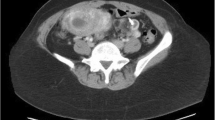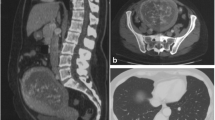Abstract
Introduction
Gestational trophoblastic disease is one form of abnormal pregnancy, with a median maternal age of 27–28 years. One complication of trophoblastic disease is the development of a secondary hyperthyroidism, which resolves rapidly after evacuation of the hydatidiform mole.
Case report
We report a case of a 53-year-old woman presenting with a complete hydatidiform mole and who developed a severe thyrotoxicosis after suction evacuation of the hydatidiform mole.
Conclusion
A severe thyriotoxicosis can occur even after surgical evacuation of the mole. Therefore, evaluation of the thyroid function prior to operation, especially with a high quantitative hCG, should be performed to avoid severe complications.


Similar content being viewed by others
References
Soper JT (2006) Gestational trophoblastic disease. Obstet Gynecol 108:176–187
Bandy LC, Clarke-Pearson DL, Hammond CB (1984) Malignant potential of gestational trophoblastic disease at the extreme ages of reproductive life. Obstet Gynecol 64:395–399
Garcia M, Romaguera RL, Gomez-Fernandez C (2004) A hydatidiform mole in a postmenopausal woman. A case report and review of the literature. Arch Pathol Lab Med 128:1039–1042
de la Fouchardiere A, Cassignol A, Benkiran L, Rudigoz RC, Gougeon A, Devouassoux-Shisheboran M (2003) Invasive hydatiform mole in a postmenopausal woman. Ann Pathol 23:443–446
Lok CA, Zurcher AF, van der Velden J (2005) A case of a hydatidiform mole in a 56-year-old woman. Int J Gynecol Cancer 15:163–166
Hirst J, Ferrier A (2004) Post-menopausal bleeding: hydatidiform mole a rare cause. Aust N Z J Obstet Gynaecol 44:462–463
Davidson SA, Gottesfeld J, La Rosa FG (1997) Molar pregnancy in a 60-year-old woman. Int J Gynaecol Obstet 56:53–55
Maudsley RF, Robertson EM (1965) Hydatidiform mole in a woman over 52 years old. Report of a case. Obstet Gynecol 26:542–543
Kato K, Mostafa MH, Mann K, Schindler AE, Hoermann R (2004) The human chorionic gonadotropin molecule from patients with trophoblastic diseases has a high thyrotropic activity but is less active in the ovary. Gynecol Endocrinol 18:269–277
Moore-Maxwell CA, Robboy SJ (2004) Placental site trophoblastic tumor arising from antecedent molar pregnancy. Gynecol Oncol 92:708–712
Narasimhan KL, Ghobrial MW, Ruby EB (2002) Hyperthyroidism in the setting of gestational trophoblastic disease. Am J Med Sci 323:285–287
Hershman JM (1999) Human chorionic gonadotropin and the thyroid: hyperemesis gravidarum and trophoblastic tumors. Thyroid 9:653–657
Misra M, Levitsky LL, Lee MM (2002) Transient hyperthyroidism in an adolescent with hydatidiform mole. J Pediatr 140:362–366
Steigrad SJ (2003) Epidemiology of gestational trophoblastic diseases. Best Pract Res Clin Obstet Gynaecol 17:837–847
Coukos G, Makrigiannakis A, Chung J, Randall TC, Rubin SC, Benjamin I (1999) Complete hydatidiform mole. A disease with a changing profile. J Reprod Med 44:698–704
Fowler DJ, Lindsay I, Seckl MJ, Sebire NJ (2006) Routine pre-evacuation ultrasound diagnosis of hydatidiform mole: experience of more than 1000 cases from a regional referral center. Ultrasound Obstet Gynecol 27:56–60
Tidy JA, Gillespie AM, Bright N, Radstone CR, Coleman RE, Hancock BW (2000) Gestational trophoblastic disease: a study of mode of evacuation and subsequent need for treatment with chemotherapy. Gynecol Oncol 78:309–312
Hershman JM (2004) Physiological and pathological aspects of the effect of human chorionic gonadotropin on the thyroid. Best Pract Res Clin Endocrinol Metab 18:249–265
Ngowngarmratana S, Sunthornthepvarakul T, Kanchanawat S (1997) Thyroid function and human chorionic gonadotropin in patients with hydatidiform mole. J Med Assoc Thai 80:693–699
Laurent V, Besson L, Doussin JF, Rondelet B, Banssillon V (1993) Hyperthyroidism induced by molar pregnancy. Ann Fr Anesth Reanim 12:424–427
Gerulath AH, Ehlen TG, Bessette P, Jolicoeur L, Savoie R (2002) Gestational trophoblastic disease. J Obstet Gynaecol Can 24:434–446
Author information
Authors and Affiliations
Corresponding author
Rights and permissions
About this article
Cite this article
Struthmann, L., Günthner-Biller, M., Bergauer, F. et al. Complete hydatidiform mole in a perimenopausal woman with a subsequent severe thyriotoxicosis. Arch Gynecol Obstet 279, 411–413 (2009). https://doi.org/10.1007/s00404-008-0734-0
Received:
Accepted:
Published:
Issue Date:
DOI: https://doi.org/10.1007/s00404-008-0734-0




